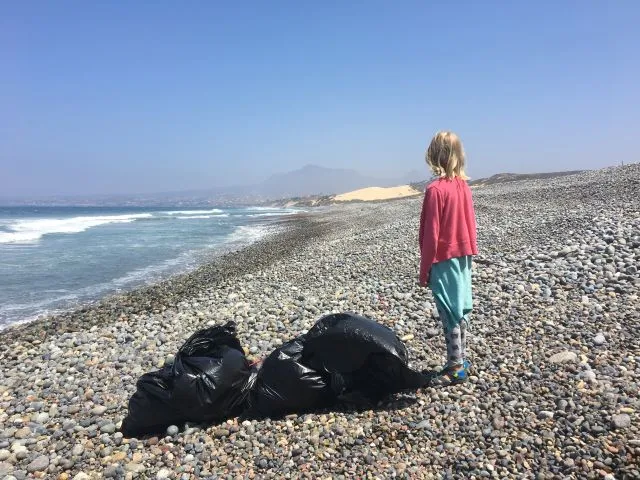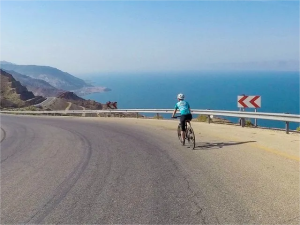Flood of Plastic Waste – Decreasing Plastic Pollution in Travel
- by Mohamed Adam

It is the vision of endless plastic garbage. When people ask about our cycling trip through Cambodia, the piles of plastic waste are burned into my memory. I politely skip over the sickening recollection of mounds of plastic pollution, and gush about Angkor Wat and the kindness of the Cambodian people.
However, the truth is, that our time in Southeast Asia brought me out of my privileged curbside-recycling world, and face to face with the global causes of plastic pollution. Dripping sweat with each pedal stroke of my bike, I reflected on how I was contributing to the effects of the plastic pollution while travelling.
How many plastic bottles had I drank from in the days in Asia? The plastic bags and styrofoam food containers carried out of restaurants and stores tumbled through my overheated brain. What number of straws and disposable cups had I gone through in just a few weeks?
Plastic Waste – An Ocean Pollution Horror Story
Plastic litter has been called by scientists, “One of this generations key environmental challenges.” A study published in May 2019, in Nature Communications, details a substantial increase in macroplastic sea pollution. Plastic bags in the ocean, fishing nets, cords, ropes, bottles, crates, pipes and buckets all contribute to a tenfold increase of plastic waste marine pollution since 1990.
It is estimated 18 billion pounds of plastic enters the earth’s waters each year. That plastic, along with other waste dumped in the ocean has created 400 dead zones. The ocean pollution effects have resulted in a combined area larger than the United Kingdom, so starved for oxygen that marine life can barely survive.
Where is the plastic pollution in the ocean coming from?
In 1955, Life magazine splashed a headline, ‘Throwaway Living’, promising to decrease the drudgery of washing dishes and cutlery. Sixty years later, plastic is being produced at supersonic rates. The production of plastic waste has far surpassed waste management model’s ability to deal with it.
The growing economies of Asia have fueled the expanded production of disposable plastic packaging. However, garbage collection systems, let alone recycling opportunities, may be nonexistent in these countries.
According to Jenna Jambeck, a University of Georgia engineering professor, the entry point for the majority of plastic in our oceans is Asia. She estimates the amount of plastic in the world’s oceans, would equal five plastic grocery bags, each stuffed with plastic trash, lining every coastline in the world.
Effects of plastic waste – What’s the big deal?
Whether strangled by abandoned fish nets or six pack rings or by ingesting microplastics (plastic that has broken down), 700 marine species are affected each year. Photos of seahorses clinging to Q-tips and dead whales, who have ingested pounds of plastic bags and bottles, fill media pages.
Ted Siegler, a Vermont resource economist who has spent a quarter century assisting developing countries on garbage solutions states, “This isn’t a problem we don’t know what the solution is. We know how to pick up garbage. Anyone can do it. We know how to dispose of it. We know how to recycle.” According to Siegler the challenge is building the necessary systems and infrastructure.
Plastic Pollution Solutions while traveling
At home we are committed to reducing our single use plastics. Our city has state of the art recycling facilities. After the slap-in-the-face plastic pollution facts from our trip to Asia, we are now focused on decreasing use of plastic when we travel.
We hope you will consider doing the same, rather than adding other challenges facing countries in dealing with their contribution to the effects of plastic pollution.
Participate in or organize a beach clean up
It is easy to say beach garbage in another country is not our problem. Or it is not our garbage. The ocean pollution effects will be felt by all of us eventually. Every piece of trash removed from the ocean or beach is part of the solution. Rather than feeling the issue is of Mount Everest proportions, each piece of garbage we all pick up is one less turtle, fish, bird or whale in danger from it.

Pack a tote bag or collapsible backpack for shopping
According to National Geographic, a trillion plastic shopping bags are used each year around the world. The number of plastic bags in the ocean is incalculable but ever increasing.
Say no to plastic straws
Unless you have medical needs, ask for drinks without straws. Alternatively bring a re-usable straw or compostable ones.
Pack your own cutlery
A reusable cutlery set is easily packed and can even be used on the plane to avoided the use of plastic cutlery handed out with meals.
Bring a water bottle
Reusable water bottles help you avoid buying plastic bottled water. In countries where water is not safe to drink use water purifying tablets or a water filter too so you can clean tap water. A collapsible, reusable water bottle takes up less space in your bag.
Avoid plastic packaging
If you’re shopping for food, go to the local markets and buy the local food that has not been wrapped in plastic.
Recycle what you can
In developing countries recycling services are often non existent. However, it never hurts to ask. At the very least don’t litter.
It is the vision of endless plastic garbage. When people ask about our cycling trip through Cambodia, the piles of plastic waste are burned into my memory. I politely skip over the sickening recollection of mounds of plastic pollution, and gush about Angkor Wat and the kindness of the Cambodian people. However, the truth is,…




